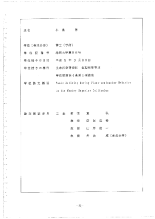Tonic activity during visuo-oculomotor behavior in the monkey superior colliculus サル上丘ニューロンの、記憶依存性眼球運動、あるいは視覚刺激に対する注意に伴う活動
この論文にアクセスする
この論文をさがす
著者
書誌事項
- タイトル
-
Tonic activity during visuo-oculomotor behavior in the monkey superior colliculus
- タイトル別名
-
サル上丘ニューロンの、記憶依存性眼球運動、あるいは視覚刺激に対する注意に伴う活動
- 著者名
-
小島, 淳
- 著者別名
-
コジマ, ジュン
- 学位授与大学
-
総合研究大学院大学
- 取得学位
-
博士 (学術)
- 学位授与番号
-
甲第56号
- 学位授与年月日
-
1993-03-23
注記・抄録
博士論文
The superior colliculus is a phylogenetically old structure located in the<br /> midbrain. It plays a key role in orienting response - movements of the<br /> eye, head, and body toward a newly appearing, salient object. Underlying<br />this response is multimodal sensory inputs (e.g., direct visual inputs<br /> from the retina) and heterogeneous motor outputs (e.g., projections to<br /> brainstem saccade generators). However, the brain receives sensory<br />inputs continually in parallel, and there must be the mechanism for<br />selection to determine to which stimulus the animal should respond.<br />Such selection requires cognitive processes such as attention, memory,<br />and movement preparation.<br />The objective of the present research was to examine whether the<br />superior colliculus is involved in such cognitive processes. For this<br />purpose we trained monkeys to perform a series of behavioral tasks and<br />recorded single cell activity from the superior colliculus while the<br /> animal was performing the tasks.<br />In these tasks the monkey was required, during a time period (2-3 sec),<br /> to select a stimulus, remember its position, or prepare for an eye<br />movement, The neural activity related to these processes was expected<br />to appear as a tonic, sustained spike discharge during the period. To<br />analyze the nature of the tonic activity we used three main tasks<br />(overlap saccade task, delayed saccade task, and attention task) and<br /> additional control tasks.<br />In the overlap saccade task (SACO), the monkey was required to make a<br />saccade to remembered position of peripheral light spot which had been<br /> cued during fixation. In the attention task (ATT), the monkey was<br /> required to detect dimming of the peripheral spot light, without making<br /> an eye movement. We assumed that these tasks would selectively or<br /> preferentially reflect different aspects of cognitive processes -<br />movement preparation, memory, and attention.<br /> We used three monkeys, After training of these tasks, monkeys were<br /> implanted with a head holder on the skull and search coil monocularly in<br /> order to monitor eye positions (Robinson 1963), under anesthesia with<br /> pentobarbital sodium. Extracellular action potential was recorded by a<br /> glass coated elgiloy electrode.<br /> We recorded 141 neurons showing tonic activities in the superior<br />colliculus. The superior colliculus consists of three layers: the<br /> superficial, the intermediate, and the deep layers. Based on previous<br /> reports which had been accepted unanimously, neurons without saccadic<br /> activity (n=33) were considered to be in the superficial layer, while<br /> neurons with saccadic activity (n=108) were in the intermediate layer.<br /> We later confirmed this assumption by histological examination.<br /> These neurons also discharged physically after visual stimuli and/or<br /> around saccade. Tonic activities had preferential retinotopic fields,<br /> which were similar to the visual receptive fields and the saccadic<br /> movement fields of the same neurons.<br />Depending on the predominance of the activities during the delay period<br /> among the three tasks (SACO, SACD, ATT), we classified the tonic<br />neurons into four types: (1) visuomotor (activity was significantly<br /> greater in SACO), (2) mnemonic motor (SACD dominant)< (3) visual<br /> attention (ATT dominant), and (4) nonspecific (others; no single task<br /> was dominant). <br />In the intermediate layer, more than a third of tonic neurons were found<br /> to be selective for one of the tasks: visual attention (n=13), visuomotor<br /> (n=13), and mnemonic motor (n=15).<br /> The other neuron (n=67) were of<br /> non-specific type. In the superficial layer, specific types were less<br /> common: visual attention (n=3) and visuomotor (n=4). Mnemonic motor<br /> type was not found. The other neurons (n=26) were of non-specific type.<br /> In conclusion, the tonic neurons in the superior colliculus, especially in its<br /> intermediate layer, are involved in information processing<br /> underlying memory of the target location, the preparation of saccade and<br /> the peripheral attention. Their signals may be sent to the phasic<br /> responsive neurons in the superior colliculus and/or the brainstem<br /> saccade generators, and modulate saccadic eye movements.<br /> Furthermore, they may be sent to the thalamic neurons, to which the<br /> neurons in the intermediate layer project, The superior colliculus might<br /> participate in the processes in which memory-, preparation-, and<br /> attention-related signals are maintained. These processes may be<br /> accomplished by multiple loop circuits formed with the cerebral cortex,<br /> thalamus, basal ganglia, and superior colliculus.
application/pdf
総研大甲第56号
目次
- CONTENTS/p4 (6コマ目)
- INTRODUCTION/p5 (7コマ目)
- I.Two visual systems/p5 (7コマ目)
- II.Superior Colliculus/p7 (9コマ目)
- III.Purpose of this study/p16 (18コマ目)
- METHODS/p18 (20コマ目)
- I.Surgery/p18 (20コマ目)
- II.Behavioral paradigms/p19 (21コマ目)
- III.Experimental procedures/p22 (24コマ目)
- IV.Histology/p23 (25コマ目)
- V.Data analysis/p24 (26コマ目)
- RESULTS/p29 (31コマ目)
- I.Difference between superficial and intermediate layers/p29 (31コマ目)
- II.Classification of the tonic neurons in the superior colliculus/p31 (33コマ目)
- III.Directional selectivity/p40 (42コマ目)
- IV.Histological data/p43 (45コマ目)
- DISCUSSION/p46 (48コマ目)
- CONCLUSION/p57 (59コマ目)
- REFERENCES/p58 (60コマ目)
- ACKNOWLEDGEMENTS/p68 (70コマ目)
